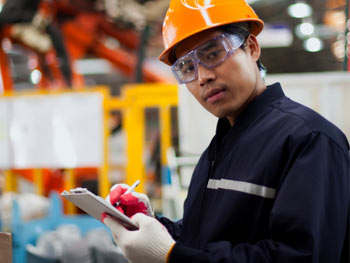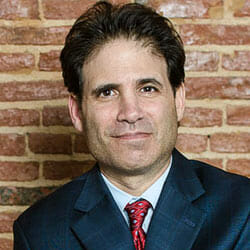 Many industries rely on powered industrial trucks (PITs) to move materials from one location to another. Commonly called forklifts or lift trucks, these workhorses carry, push, pull, lift and stack heavy goods, no doubt eliminating many musculoskeletal injuries of workers on industrial sites. However, if their operators are not adequately trained or the equipment is not properly maintained, serious injuries and fatalities can – and do – result.
Many industries rely on powered industrial trucks (PITs) to move materials from one location to another. Commonly called forklifts or lift trucks, these workhorses carry, push, pull, lift and stack heavy goods, no doubt eliminating many musculoskeletal injuries of workers on industrial sites. However, if their operators are not adequately trained or the equipment is not properly maintained, serious injuries and fatalities can – and do – result.
According to data compiled by the Occupational Safety and Health Administration (OSHA), there are about 35,000 serious injuries and 85 deaths each year from forklift accidents. In fact, one out of every six workplace fatalities are forklift related. The industries in which most forklift accidents occur are manufacturing, construction, wholesale trades, transportation, retail trade, and mining. For those in the construction industry facing such incidents in Maryland, consulting with a construction accident attorney in Baltimore, MD, can be a crucial step for understanding legal rights and seeking justice.
What are the most common causes of forklift accidents?
These are the main reasons workers are hurt or killed in forklift mishaps:
- Lack of adequate training
- Operator error
- Poor maintenance
- Workplace conditions.
Let’s take a look at each of these areas to see how could contribute to the dangers involved in forklift use.
Training for Forklift Operators
To begin with, it is a violation of Federal law for ANYONE under 18 years of age to operate a forklift, regardless of how much training they may have been given. Furthermore, employers must train and certify anyone who will be given the responsibility for operating a powered industrial truck, according to the specific requirements of OSHA regulations.
There are numerous types of powered industrial trucks, and operators must be trained on each different type they will be operating. The training must be site-specific, to address the particular conditions of the workplace, such as ramps, slopes, surface conditions, locations of hazards and pedestrian traffic in the area.
OSHA requires that forklift training be conducted by “persons with the necessary knowledge, training, and experience to train powered industrial truck operators and evaluate their competence.” That means it can’t be done by the office manager, unless the office manager is also an experienced forklift operator. Each forklift driver MUST be evaluated every three years to assure that they are still qualified to safely operate the equipment.
Additionally, under certain circumstances, the company must provide refresher training: (1) whenever an operator has been observed operating unsafely; (2) when the operator has been involved in an accident or a near-miss; (2) after an operator has received an unsatisfactory evaluation; (3) when an operator is switched to a different type of PIT; and (4) when changes in workplace conditions have been made that could affect safe operation.
The areas in which forklift operators must be trained are comprehensive and include the following, as well as many others: machinery controls and instrumentation; steering and maneuvering; capacity and stability limits; inspection and maintenance procedures; warnings and precautions; load manipulation, stacking and unstacking; workplace and environmental conditions.
Clearly, when an employee is assigned to operate a piece of equipment that weighs two or three times as much as a car, handles differently than a car, and moves while lifting heavy loads up in the air, that worker (and others in the area) deserves to be protected by thorough and effective training.
Accidents Caused by Operator Error
It’s true that all the objective training in the world cannot completely eliminate the dangers of subjective human behavior. Careless operation threatens not only the safety of the driver but of other workers in the area. Almost 80% of forklift accidents involve a pedestrian, many of whom have their feet run over or are struck by a reckless operator.
These are some of the dangerous behaviors that can cause forklift accidents:
- Driving at excessive speed. OSHA recommends 5 mph as the maximum speed while driving a forklift. The equipment should be outfitted with a speedometer, there should be posted speed limits, and employers should expect operators to obey them.
- Riding with an elevated load. OSHA recommends that forks be carried as low as possible, consistent with safe operations, usually 4 inches off the floor.
- Using improper backing, turning or braking techniques.
- Horseplay or giving others a ride on the lift or load.
- Shortcutting equipment inspection and maintenance.
Maintenance of PITS
OSHA requires that all forklifts be examined at least daily, and BEFORE being used. In situations where they are used around the clock, they must be inspected after each shift. The inspection should cover things such as fluid levels, leaks or cracks in hydraulic hoses and mast chains, tire condition and pressure, finger guards, safety equipment including seat belt, and the back-up alarm function.
When defects are found, they must be immediately reported and corrected. In some situations, production pressures may tempt workers to underestimate the seriousness of a maintenance issue or to procrastinate in reporting and repairing the problem. In other cases, management delays or incompetence may expose forklift operators to serious dangers.
Workplace Conditions
A warehouse or construction company can be liable for negligence if they fail to correct hazardous elements of workplace design or allow dangerous conditions to exist.
Narrow, cluttered aisles in warehouses can cause collisions with merchandise, pallets and other equipment.
Poor lighting makes it difficult for forklift operators to safely navigate down aisles, around corners and through doorways. Headlights should be used where general lighting is less than two lumens per square foot
Employees of manufacturing facilities often are subject to conditions such as noise, odors, toxic gases and dust.
Protecting the Rights of Maryland Workers
For more than 25 years, Steve Heisler, The Injury Lawyer, has been advocating for the rights of employees to a safe workplace and compensation when negligence causes a workplace injury or death. As a trusted Maryland workplace injury lawyer, Steve Heisler provides essential support for families, offering relief from staggering medical bills, assistance with household expenses, and monetary compensation for loss of companionship.
If you or your loved one has been hurt in a forklift accident on a jobsite in Maryland or the District of Columbia, call the Law Offices of Steven H. Heisler at (410) 625-4878. As a former union organizer, Steve values the rights of hardworking men and women and won’t back down when faced with resistance from industry and insurance managers. You’ll be glad to have Steve on your side and by your side as you deal with your occupational injury.

Attorney Steve Heisler
Steve Heisler decided in 1996 that he was going to focus his law practice exclusively on injury cases. Since then, he has been representing injured people against insurance companies, disreputable medical practitioners and Big Pharma, and doing it with compassion, honesty and level-headed rationality. [ Attorney Bio ]

